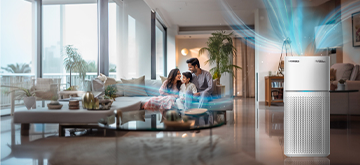
Understanding the Air Quality Index (AQI): Definition and Mechanism
PUBLISHED ON: 06-Mar-2024
Air pollution is a major concern in both developed and developing countries, harming the health and well-being of millions of people around the world. The Air Quality Index (AQI) is a highly effective tool for understanding and expressing air pollution levels. This article provides a full understanding of the Air Quality Index by covering the AQI definition, its process, and measurement, as well as the role of air purifiers in improving indoor air quality.
What is the Air Quality Index (AQI)?
The Air Quality Index (AQI) is a numerical scale for reporting and forecasting daily air quality values. It represents complex air pollution statistics in an understandable manner, enabling the general population to make educated decisions regarding their health and outdoor activities.
The AQI also focuses on health consequences that might arise within hours or days after exposure to air pollutants like ground-level ozone, particulate matter, carbon monoxide, sulfur dioxide, and nitrogen dioxide.
Generally, AQI is categorised into six different categories:1
- Good (0-50)
- Satisfactory (51–100)
- Moderate (101–200)
- Poor (201-300)
Severe (301–500)
How to Measure AQI?
Air pollutants originate from various sources, including human activities like using fossil fuels in vehicles and cooking and natural emissions through dust storms and other nature-induced events. You can use an air quality monitor to determine the air quality. These devices have sensors that identify both man-made and natural pollutants, providing the Air Quality Index (AQI) for a location. The AQI scale ranges from 0 to 500. While, an AQI of 50 or below is safe, while readings over 100 are considered unhealthy.1
Why do you need Air Purifiers for AQI?
Air purifiers are essential for ensuring adequate interior air quality, particularly in urban areas with high levels of outdoor pollution. Here are some reasons why air purifiers are vital for increasing the air quality:
1. Eliminate Allergens
Air purifiers can remove allergens including pollen, dust mites, and pet dander. Forbes Air Purifier 150 Surround 360° Air Purifier comes with Surround 360° Air Intake Technology that can eliminate bacteria, dust, allergens, and odour from all directions, offering you clean and pure air.
2. Reduce pollution exposure
Air purifiers like Forbes Air Purifier 355 Surround 360° Air Purifier have a wide range of filters such as HEPA and Activated Carbon filters that can remove dangerous pollutants such as Volatile Organic Compounds (VOCs) and smoke that cause air pollution. Moreover, these air purifiers can remove ultra-fine particles like pollen, mould, and microbes as small as 0.1 um due to the inclusion of a True H13 HEPA filter.
3. Improve your overall well-being
Cleaner air promotes better sleep, cognitive function, and energy levels.
How do Air Purifiers Improve the Air Quality of your home?
Air purifiers remove dust, pollen, bacteria, viruses, and other fine particles from the indoor air. They (air purifiers) incorporate various filters, including Pre-filter, True H13 HEPA Filter, Activated Carbon Filter, and Plasma Filtration. These filters improve your home's air quality by removing various contaminants. Here's how air purifiers improve air quality
1. HEPA filters
High Efficiency Particulate Air (HEPA) filters can catch 99.97% of particles as small as 0.1 microns, such as dust, pollen, mold spores, and pet dander. Air purifiers like Forbes Air Purifier 355 Surround 360° Air Purifier and Forbes Air Purifier 150 Surround 360° Air Purifier are equipped with True H13 HEPA Filter that traps ultra-fine dust, pollen, bacteria, viruses, and other fine particles to provide you with pure and clean indoor air.
Recently, Eureka Forbes launched two new air purifiers– Forbes Air Purifier 355 Surround 360° Air Purifier and Forbes Air Purifier 150 Surround 360° Air Purifier ideal for Indian households. These air purifiers are equipped with the surround 360° Air Intake Technology that swiftly captures bacteria, dust, allergens, and odors from all directions, delivering clean and pure air.
Here are some of the features of these air purifiers:
- The air purifier features advanced filters like Pre-filter, Activated Carbon filter, True H13 HEPA filter, and Plasma Filtration that can remove dust and particule of 0.1 um
- Real-time PM 2.5 digital display lets you know the quality of your indoor air
- It also has auto-sense mode and sleep mode that works autonomously to provide you with clean and fresh indoor air round-the-clock
2. Activated Carbon Filters
Activated Carbon Filters are made up of small bits of carbon that have been processed to be extremely porous. They are extremely effective at removing odours, Volatile Organic Compounds (VOCs), and smoke.
3. Air quality indicators
Many new air purifiers have a PM 2.5 digital display that measures and showcases real-time air quality. For instance, Forbes Air Purifier 355 Surround 360° Air Purifier features a PM 2.5 digital display that shows the real-time air quality with a colour indication for easier understanding. Moreover, the air purifier is equipped with Surround 360° Air Intake Technology that swiftly captures bacteria, dust, allergens, and odours from all directions. This technology (Surround 360° Air Intake Technology) along with advanced filters like Pre-Filter, Active Carbon Filter, True H13 HEPA Filter, and Plasma Filtration, enables the air purifier to purify 90% of your space in just 10 minutes.
Conclusion
Understanding the Air Quality Index (AQI) is critical for protecting ourselves and our loved ones from the negative consequences of air pollution. Knowing the AQI levels in our surroundings allows us to make more informed judgments regarding outdoor activities and take steps to enhance indoor air quality. Investing in a decent air purifier can help us maintain healthy indoor air quality and promote overall well-being.
References
- Bedi, T. K., & Bhattacharya, S. P. (2021). An investigative study on perceived indoor air quality during COVID-19 lockdown in India. Journal of the Institution of Engineers (India): Series A, 102(4), 885–900. https://doi.org/10.1007/s40030-021-00546-9 /Accessed on 14/02/2024.
